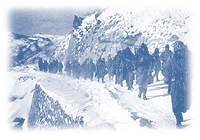|
History
Overview on the Korean War 1950-1953
Shortly
before dawn on 25 June 1950, seven infantry divisions and
one armored division of the North Korean People's Army crossed
the 38th  Parallel
into South Korea, quickly brushing aside resistance, the
North Korean juggernaut captured the South Korean capital
city of Seoul within three days. Parallel
into South Korea, quickly brushing aside resistance, the
North Korean juggernaut captured the South Korean capital
city of Seoul within three days.
The
Security Council of the United Nations quickly declared
the North Korean attack a breach of world peace, and requested
member nations to aid the Republic of Korea in driving back
the hostile force. On 29 June, President Harry S. Truman
authorized the sending of U.S. forces to the area.
A request
for the immediate employment of Marines came on 2 July from
General Douglas MacArthur, USA, the Commander-in-Chief,
Far East. Within five days of General MacArthur's request,
the 1st Provisional Marine Brigade, with its major elements
built around the 5th Marines and Marine Aircraft Group 33,
had been formed at Camp Pendleton, California. On 12 July,
the 6,534-man brigade sailed from San Diego, California
to answer their nation's call for help. As they had been
for 175-years, the Marines were ready.
For
the next three years, the performance of the 1st Marine
Division and the 1st Marine Aircraft Wing in helping to
stem the tide of Communist aggression in Korea was nothing
less than outstanding. In addition to their specialty of
amphibious operations, Marines were called upon to fight
alongside the Army in land campaigns. Such unfamiliar names
as Inchon, Seoul, and the Chosin Reservoir soon joined Belleau
Wood, Guadalcanal, and Iwo Jima in the pantheon of Marine
Corps history. The American people had great reason to be
proud of their Marine Corps.
During
the Korean War, the ground operations of the Marine Corps
can be divided into six distinct periods. They are:
August-September
1950-Defense of the Pusan Perimeter
September-October
1950 Assault on Inchon-Seoul
November-December 1950-Chosin Reservoir Campaign
January 1951-March 1952-The East-Central Front
March 1952-July 1953-The Western Front
July 1953-February 1955-Post-Armistice period
Reference
Section
History and Museums Division.
|
|
|
Top
of Column
|
|
|
0
|
There
are a few links from the menu above that may not be in the Korean War
Commemoration section of this site. To return back to this menu look for
the following icon:

KWC
MENU
|
0
|
|
|
Bottom
of Column
|
|
|